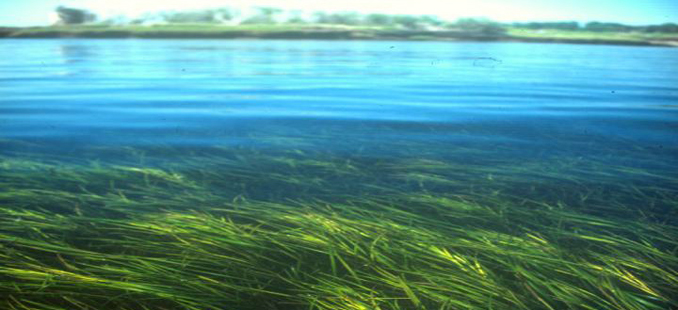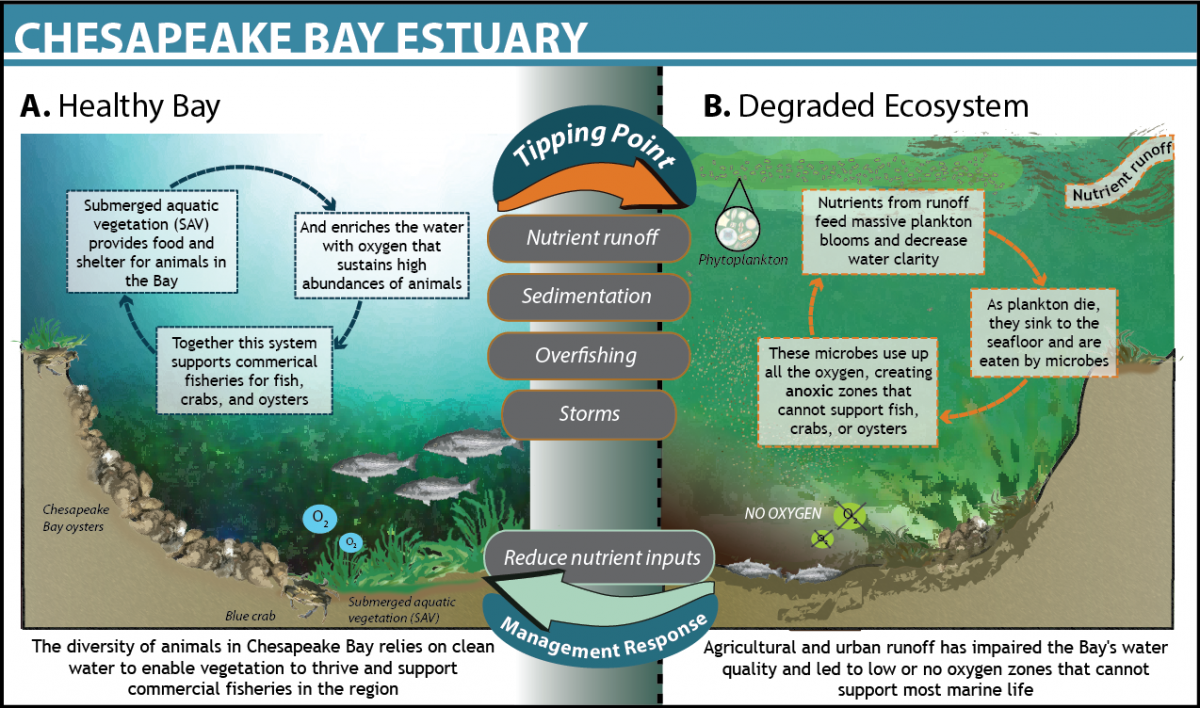Once supporting highly productive fisheries for oysters, crabs and fish, Chesapeake Bay now suffers from massive dead zones and poor water quality
Tipping points for Chesapeake Bay
Chesapeake Bay is the largest estuary in the United States and considered one of the most biologically diverse in the nation.1 The Bay is home to huge numbers of fish, oysters, crabs and shrimps, as well as seagrasses and other submerged aquatic vegetation. Aquatic vegetation is highly important to estuaries as it provides habitat, food, and oxygen to support a diverse array of marine life as well as the productive fisheries in the Bay. However, overfishing and land use changes within the Chesapeake Bay Watershed over the last two centuries have resulted in decreased water quality entering the Bay and adverse effects to aquatic vegetation and other marine species.2
Urbanization and agricultural land use changes have resulted in decades of nutrient runoff and sediment pollution entering the Bay. In the late 1960s, there was an unprecedented decline in submerged aquatic vegetation throughout Chesapeake Bay, which continued through the 1970s.2 High levels of nutrients entering the Bay lead to phytoplankton blooms, decreased water clarity, and hypoxic (low oxygen) conditions, or “dead zones,” that cannot support most marine animals.2
How Managers Tackled the Problem
The massive loss of submerged aquatic vegetation in Chesapeake Bay prompted an initial five year, multi-million dollar study, the beginning of the Chesapeake Bay Program and the establishment of governance to oversee massive restoration efforts.2 A second Chesapeake Bay agreement signed in 1987 called for collaborative commitments to reduce nutrient and sediment pollution, reduce nitrogen and phosphorus entering the Bay by 40% by 2000, and determine the environmental quality necessary to support marine life in the Bay. Continued efforts to restore the Bay have included a submerged aquatic vegetation listing under the US Clean Water Act.2
In 1989, the collaborative Submerged Aquatic Vegetation Management Policy was enacted with the goal of increasing aquatic vegetation distribution, abundance, and species diversity, and an Implementation Plan was constructed the following year to ensure the goals of the plan could be reached.2 Also incorporated into Bay restoration were initiatives from Chesapeake Bay fisheries to support Bay recovery, including the Blue Crab Fishery Management Plan.
In 2010, the Environmental Protection Agency (EPA) established a significant and comprehensive Total Maximum Daily Load (TMDL) requirement that sets limits on nutrients and sediments running into the bay, with heavy and strict accountability measures.3 This requirement divides pollution limits by jurisdiction and major river basin and is based on monitoring data, peer-reviewed science, and modeling tools. Collaborative efforts continue for the restoration of Chesapeake Bay. New targets have been set for a further 60% reduction in nutrient runoff by 2017, and full restoration by 2025.3
What We Can Learn
The scale and scope of the Chesapeake’s problems necessitates effective communication, collaboration and adaptive management among scientists, resource managers, politicians, and the general public across a very large geographic area (six states and the District of Columbia form its watershed). Restoration has proven expensive, challenging, and slow. Within these past few decades, collaboration has resulted in a growing number of policies, plans, regulations and laws that emphasize the value of aquatic vegetation in Chesapeake Bay and the need to protect and restore it.2 Implementation of these policies has relied heavily on voluntary adoption of best management practices by farmers and the educational, technical and financial support of many groups. Today, the Bay remains precariously out of balance, but incremental change over the last few years suggests that all the work and expense may be starting to pay off: the Bay appears to be on a positive trajectory, toward what managers and policymakers hope is a positive tipping point.
As the Ocean Tipping Points team has come to understand, the most successful scenarios for resource management occur when management is threshold-based, populations are monitored routinely, and the geographic scale for management is relatively small.
Learn more about our Management Review research and Ocean Tipping Points project.






